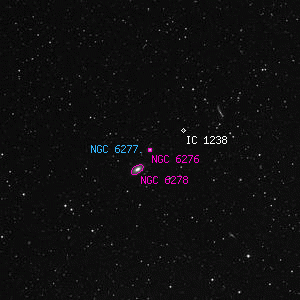NGC 6276

Overlaid DSS image of NGC 6276, 30' x 30' with north at top and west to the right
Aladin viewer for the region around NGC 6276
IC 1239, MCG+04-40-010, NPM1G +23.0441, PGC 59419, SDSS J170045.08+230238.4
| Type | Galaxy |
|---|---|
| Magnitude | 15 |
| Size | 0.403' x 0.331' @ 145° |
| Right Ascension | 17h 0' 44.9" (2000) |
| Declination | 23° 2' 38" N |
| Constellation | Hercules |
| Description | eF |
| Classification | SABa |
Observing Notes
Harold Corwin
NGC 6276 = IC 1239, NGC 6277 (a star), and NGC 6278. William Herschel found one galaxy here. It, NGC 6278, as one might expect, is the brightest of the group. Sixty years later, Albert Marth found two other nebulous objects near Herschel's object. Shortly thereafter, Stephan also discovered two nebulous objects, and also included Herschel's object in his list, correcting Herschel's inaccurate position. However, Stephan did not mention Marth's two objects; I don't know if he was aware of Marth's list or not.
Dreyer, faced with this rather confusing array of five positions, asked to see Marth's observing records. These apparently did not reach Dreyer until after the NGC had gone to press, as he added a note "in press" to the NGC that Stephan had seen only one of Marth's objects. The positions are close enough that Dreyer was able to correctly identify the object (NGC 6276) as m328. m327 is north preceding about three arcminutes, and was missed by Stephan. In the NGC note, Dreyer added that the missing object should have been inserted in the NGC immediately following NGC 6275. Dreyer indeed added it later to the first Index Catalogue as IC 1238.
But when we turn to the sky, there are only two galaxies here bright enough to have been seen by the visual observers (a third, later catalogued as UGC 10650, has too low a surface brightness to have been picked up). The brightest is obviously NGC 6278, but what is the other? Fortunately, Stephan's micrometric position is pretty good, being off only by the amount that his comparison star's catalogued position is off (about half an arcminute). This correctly identifies the second galaxy as NGC 6276. If we then correct Stephan's position for NGC 6277 for the comparison star's offset, we find that this object is in fact a star. Assuming that Marth's two positions are in good relative agreement, we can pin down IC 1238 as a double star.
The confusion crept into Bigourdan's observations, too. He correctly identified NGC 6278, but misidentified a star as NGC 6277, and actually published NGC 6276 as a "nova" in his second list of new nebulae. He later realized his mistake, and correctly equated the NGC object with his "nova" (which had by then received the number IC 1239) in his final published list of observations. His observation of "NGC 6277" is interesting in that there is a faint galaxy just a few arcseconds north-following the star he measured. Did he perhaps glimpse the galaxy, but then measure the brighter star?
Sulentic, with three NGC numbers in hand, and with three relatively large galaxies in sight on the Sky Survey, misidentifies UGC 10650 as RNGC 6276, and assigns the number RNGC 6277 to NGC 6276. NGC 6278's correct identification survived even into the RNGC.
Other Data Sources for NGC 6276
Associated objects for NGC 6276
Nearby objects for NGC 6276
Credits...
Drawings, descriptions, and CCD photos are copyright Andrew Cooper unless otherwise noted, no usage without permission.
A complete list of credits and sources can be found on the about page
NGC 6276